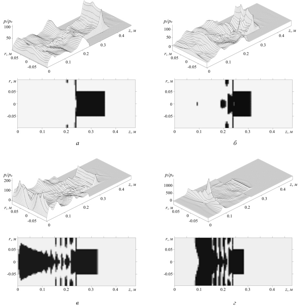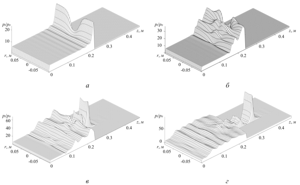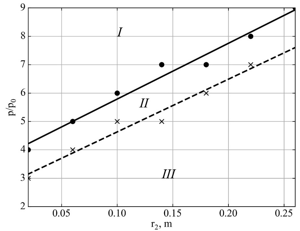

The processes of reflection and diffraction of a pressure wave in a cylindrical channel filled with a bubbly liquid are considered in the presence of an abrupt decrease in the channel diameter. The case is considered when the gas phase of the bubbly liquid is an explosive gas mixture. The main purpose of the work is numerical study of the dynamics of detonation waves in a bubbly liquid with an abrupt decrease in the diameter of a cylindrical channel. To numerically analyze the evolution of waves in a cylindrical channel filled with a bubbly liquid, a system of equations in Lagrangian variables was used, where the Eulerian coordinates at the initial moment of time are taken as Lagrangian variables. An acetylene-oxygen stoichiometric mixture was used as the gas phase for calculations. As a liquid phase, a water–glycerin solution with a mass fraction of 0.5 glycerin was used. It is shown that when high-pressure waves pass through cylindrical channels with an abrupt decrease in diameter containing a bubbly liquid with a combustible gas, both continuous propagation of detonation and attenuation of detonation are possible; and the transition from one detonation mode to another depends not only on the transverse dimensions of the narrow part of the channel, but also on the volume content of bubbles. It has been established that when high-pressure waves pass through cylindrical channels with an abrupt decrease in diameter containing a bubbly liquid with a combustible gas, detonation can be caused by the following reasons: collision of an incident wave with rigid walls in the area of channel diameter reduction; as a result of interference of waves during propagation from a wide to a narrow part of the channel. An analysis of the dynamicsof detonation wave propagation shows that with a low volume gas content, detonation is formed only when high-pressure waves pass into a narrow part of the channel in the direction of the incident wave movement due to wave interference.
bubbly liquid,
detonation,
explosion initiation,
cylindrical channel
The processes of reflection and diffraction of a pressure wave in a cylindrical channel filled with a bubbly liquid are considered in the presence of an abrupt decrease in the channel diameter. The case is considered when the gas inside the bubbles is explosive.
PURPOSE
Numerical study of the dynamics of detonation waves in a bubbly liquid with an abrupt decrease in the diameter of a cylindrical channel.
METHODOLOGY
A cylindrical channel filled with a gas-liquid mixture with an abrupt change in the cross-sectional area is considered. It is assumed that the gas phase of the bubbly liquid is an explosive gas mixture.
At the initial moment of time
The following assumptions are made to describe the two-dimensional axisymmetric wave motion of a bubble medium: The mixture is monodisperse, i.e. in each elementary volume all the bubbles are spherical and of the same radius, viscosity and thermal conductivity are significant only during interphase interaction and, in particular, during bubble pulsation. There is no mass transfer between bubbles and liquid.
To numerically analyze the evolution of waves in a cylindrical channel filled with a bubbly liquid, it is more convenient to use a system of equations in Lagrangian variables. The Eulerian coordinates at the initial moment of time are taken as Lagrangian variables.
An acetylene-oxygen stoichiometric mixture is used as the gas phase for calculations. As a liquid phase, a water–glycerin solution with a mass fraction of 0.5 glycerin.
FINDINGS
When high-pressure waves pass through cylindrical channels with an abrupt decrease in diameter containing a bubbly liquid with a combustible gas, both continuous propagation of detonation and attenuation of detonation are possible. The transition from one detonation mode to another depends not only on the transverse dimensions of the narrow part of the channel, but also on the volume content of bubbles.
Studies also show the dependence of the critical radius required for detonation initiation in a bubbly liquid on the volume gas content. An increase in the volume gas content in the range from 1 to 5% leads to an increase in the critical radius by 10%. There is also a weak dependence of the critical radius on the bubble radius: increasing the bubble radius from 1 mm to 2 mm increases the critical radius by 3%. Numerical calculations have shown that when a step pulse is formed, the value of the critical radius practically does not depend on the distance to the narrow part in the cylindrical channel; in this case, the oscillations present in the step can have a small effect.
ORIGINALITY
It has been established that when high-pressure waves pass through cylindrical channels with an abrupt decrease in diameter containing a bubbly liquid with a combustible gas, detonation can be caused by the following reasons:
An analysis of the dynamics of detonation wave propagation shows that with a low volume gas content, detonation is formed only when high-pressure waves pass into a narrow part of the channel in the direction of the incident wave movement due to wave interference.






